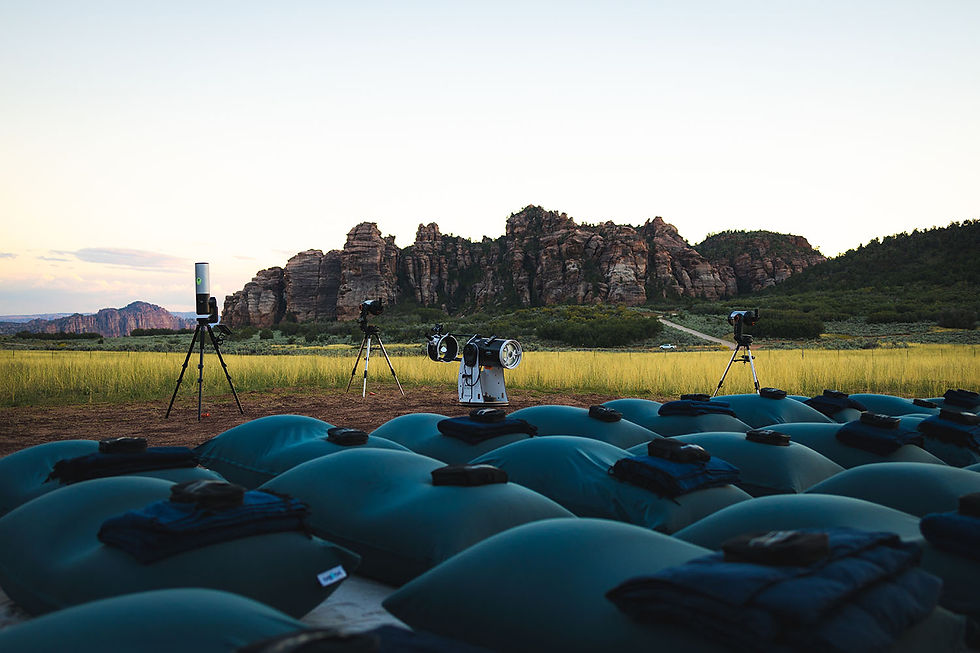Winter Stargazing in Zion: Origins of Orion and the Radcliffe Wave
- Kyle Miller

- Apr 1, 2023
- 3 min read
Updated: Apr 2
Winter stargazing in Zion can be a bit more chilly, but is one of our favorite stargazing seasons in Utah! Despite being unusually cold and snowy (although somewhat predicted by Punxsutawney Phil on GroundHog day, an astronomical occasion once known as Candlemas) we have had plenty of great nights with good views of the stars. Astronomical spring started on March 20, the Vernal Equinox. This is the day when the sun appears to rise due East and set due West and day and night are of equal length. Many of the grand vistas of the winter sky are still visible this coming month, along with a few interesting events!
Viewing Orion in Utah
In the early evening the constellation of Orion is still visible, just below the outer Perseus arm of the Milky Way (while winter stargazing in Zion, the night sky is a window out to the universe whereas in the summer we are looking into the center of the galaxy). This constellation contains the closest visible region of star formation: the Orion Nebula. Located in a recently discovered structure called the Radcliffe Wave, this region of star formation is thought to contain approximately 4,000 - 10,000 stars, including a behemoth that is about 40 times the mass of the sun.
Binoculars will reveal a foggy patch, while moderate sized telescopes will split the center star in the sword of Orion into a quartet known as the Trapezium. See images below.

Radcliffe Wave, Image credit: Roberto Mura via Wikipedia

Image: Visualization of the Radcliffe Wave. Source: Alyssa Goodman / Harvard University.
Below is a sketch of the Orion Nebula that appeared in Account of the Great Nebula in Orion, Harvard College Observatory Annals, vol. 5, published in1867. The volume’s author created the frontispiece based on numerous observation. You can make out the trapezium in this sketch.

Source: Astronomy Magazine, Inside the Orion Nebula, Raymond Shubinksi.
These four central stars are actually a system of eleven and they are responsible for the enchanting emission nebula. These massive blue giants are pumping out copious amounts of ultraviolet light (their stellar winds are moving at an astounding 4 million miles per hour), which can ionize the surrounding gas causing it to glow in various colors. The ghostly green of doubly ionized oxygen cannot be recreated on earth in even the most vacuous laboratory vacuums. Only an electronic sensor can bring out these wonders, as shown in the image below from one of our electronic Unistellar telescopes.

Image Source: Stargazing Zion, Viewing of the Great Orion Nebula on March 25, 2023.
The Origin of Orion
The origin of the Orion nebula is still somewhat a mystery. It is quite young, no more than a million years old and is located at the end of a stream of star formation stretching back towards the sun. This nebula is approximately 1,300 light years away from Earth. The sun is, oddly enough, located at the center of a structure called the local bubble (see below image), although it is an interstellar interloper. This region is thought to have been formed by supernovae 10-20 million years ago. As large stars finish burning their fuel they quickly burst like fireworks — generating heavy elements, seeding planet formation, and sending off shockwaves that can ignite new rounds of star formation.

Image Source: https://aladin.u-strasbg.fr/AladinLite/
The image above shows the Orion region in Hydrogen alpha (false color) from the Finkbeiner map. Notice the spherical shapes centered on the Orion nebula and Orion’s head. These are likely the result of supernovae ionization fronts. The galactic plane runs along the top left of the image.

Stellarium simulation of The Field near Zion National Park for April15, 2023. The red lines indicate the orbits of the planets (the ecliptic) and the orange line is the central plane of the Milky Way Galaxy (the galactic equator). Interesting deep sky objects are indicated by yellow markers.
Winter Stargazing in Zion
To view Orion during the crisp months in Utah, book a stargazing tour with Stargazing Zion. We provide plush pods, blankets and hot chocolate to keep you warm if your join us and embark on some winter stargazing in Zion! This unique time of year includes less crowds in Zion, clear skies, a window to the universe and opportunities to view the Orion Nebluae!



Comments